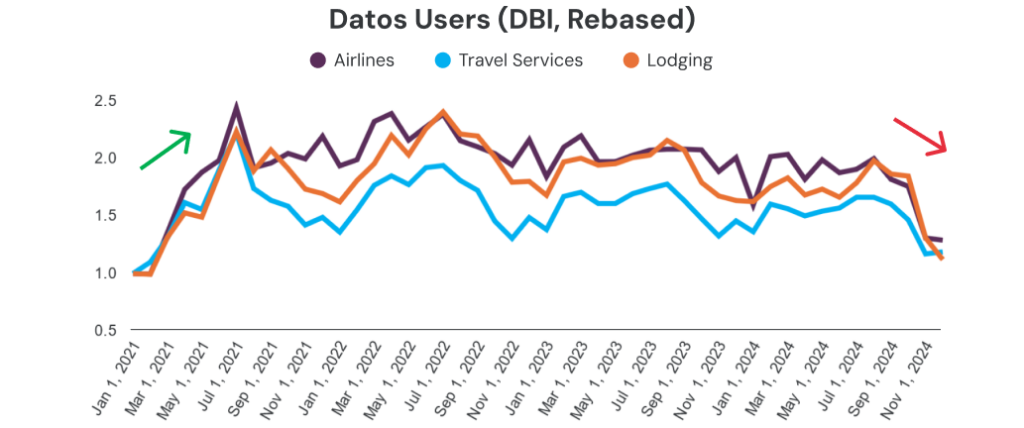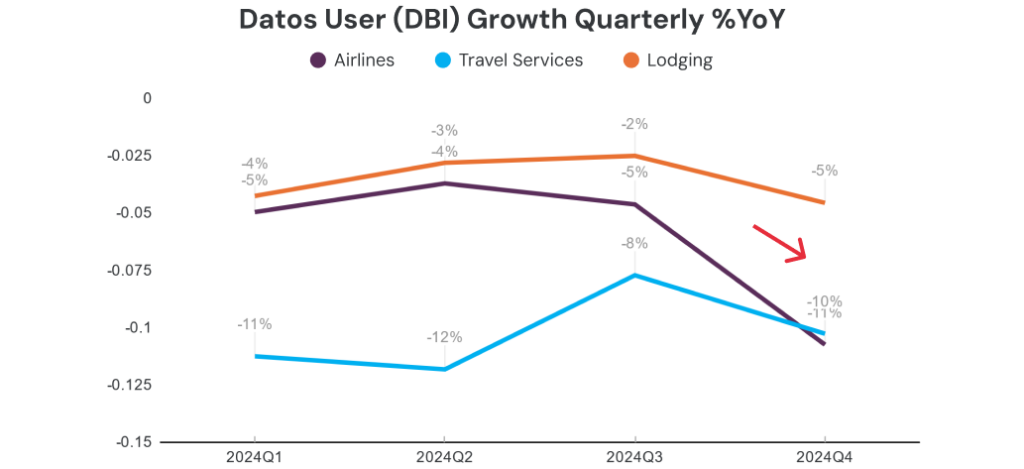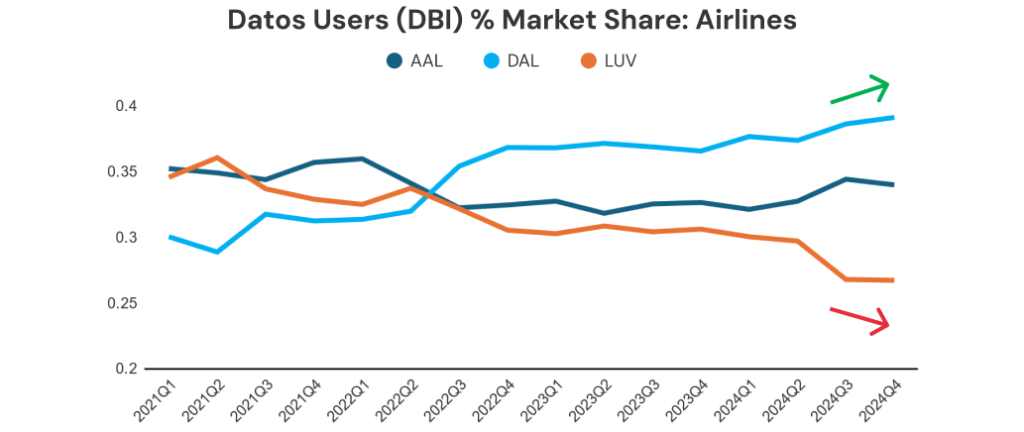Normalization and Structural Shifts in 2024
Following a strong recovery in 2023, the travel industry has transitioned from a period of resurgence to one of stabilization and divergence. While consumer travel demand has largely returned to pre-pandemic levels, 2024 was defined by shifting dynamics across different customer segments.
Within airlines, premium and international travel have shown resilience, driven by high-income consumers and destination leisure. In contrast, economic uncertainty and inflationary pressures have softened demand for low-cost carriers, particularly among middle-class travelers.
Datos Behavioral Index (DBI) data provides granular insights into these evolving trends, offering a contrast between declining user growth and shifting market shares with the strong stock performance of airlines in the latter half of 2024. As companies report Q4 2024 performance, forward guidance remains mixed, with outlooks varying based on market positioning, segment focus, and cost management. DBI data serves as a powerful analytical tool, enabling investors and industry stakeholders to track behavioral shifts and emerging trends with greater precision.
This report leverages DBI clickstream data alongside company financials to reveal key takeaways on the state of the travel industry and the competitive landscape among airlines.
Travel Industry Performance Post-COVID
The trajectory of post-pandemic travel has followed a well-defined pattern. In 2021, partial recovery was fueled by vaccine rollouts, enabling cautious returns to travel. By 2022, “revenge travel” drove demand surges, accompanied by rising airfare and accommodation prices due to inflation.
The industry achieved full recovery in 2023, with leisure travel rebounding to 2019 levels across both domestic and international markets.

In 2024, the industry entered a phase of normalization, marked by structural shifts. Economic uncertainty has led to softened growth among price-sensitive travelers, while high-income segments continue to drive premium and international travel demand.
In the second half of 2024, we see declining user growth in the DBI data across all travel industries amidst an incredible run up in stock prices through the end of the year. Investigating and understanding this divergence is critical for investors and industry stakeholders for navigating the evolving travel landscape in 2025.

Shifts in Airline Market Share
After understanding industry level trends, we can double-click into company-level comparisons to identify the winners and losers given the recent shifts. Looking at the market share dynamics within the airline sector illustrates the impact of differentiated offerings.
Examining three major U.S. airlines – Delta Air Lines (DAL), American Airlines (AAL), and Southwest Airlines (LUV) – we see a pattern emerging:

- Delta Air Lines (DAL): As a premium carrier with extensive international partnerships, Delta has gained market share, benefiting from increased demand for long-haul and business-class travel. Its airline alliance further expands its network reach.
- American Airlines (AAL): Positioned as a hybrid between premium and mid-tier offerings, American has maintained stable market share. While it offers the most destinations overall, it faces strong competition from Delta in the international segment.
- Southwest Airlines (LUV): As a mid-tier and discount carrier, Southwest has experienced market share erosion due to shifting consumer behavior. Economic headwinds have disproportionately impacted price-sensitive travelers, leading to a relative decline in demand for budget-friendly airlines.
These trends underscore how macroeconomic factors and evolving consumer preferences are reshaping the airline industry’s competitive landscape and can be monitored using the DBI data.
Industry KPIs and Predictive Insights
A key advantage of the Datos Behavioral Index is its ability to track granular user behavior, offering insights beyond traditional industry metrics. By analyzing website traffic to key segments – such as checkout pages and order confirmations – DBI provides low-latency (t+1) indicators of airline website performance.
Historical analysis from Q1 2021 through Q4 2024 demonstrates strong correlations between DBI metrics and key airline performance indicators. For example, Revenue Passenger Miles (RPM) exhibit a 94% correlation with booking activity and a 98% correlation with overall user growth on airline websites. This level of granularity enables investors and analysts to monitor quarterly performance trends with greater precision, offering a predictive edge in evaluating earnings results and market positioning.

Conclusion
The travel industry’s 2024 narrative is one of stabilization and divergence. While the industry as a whole has normalized following its post-pandemic recovery, economic pressures have created distinct winners and losers.
Looking into airlines, premium travel remains a growth driver, propelling market leaders like Delta, while budget-conscious travelers face headwinds, impacting low-cost carriers such as Southwest.
Datos Behavioral Index data continues to serve as a powerful tool in deciphering these trends, providing forward-looking insights into airline performance and broader travel industry shifts.



